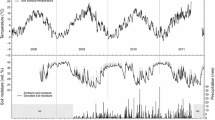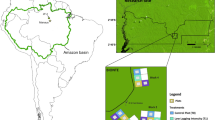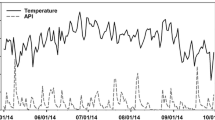Abstract
Respiration supports growth and maintenance processes and returns a substantial portion of the CO2 fixed by photosynthesis to the atmosphere each year. Investigating stem respiration using CO2 flux measurements is complicated by uncertainty surrounding the source of CO2 diffusing from tree stems. Over 2 years we measured the stem efflux from 24 trees exposed to ambient or elevated CO2. The rate of stem CO2 efflux increased with annual tree diameter increment and the estimated uptake of dissolved CO2 from the soil. To determine the source of CO2 diffusing from tree stems, we used the fumigation gas at the Duke Forest Atmosphere Carbon Transfer and Storage-1 elevated-CO2 experiment as a 13C tracer and measured the presence of soil CO2 in stem efflux on a subset of these trees. The isotopic composition of soil CO2 explained a considerable portion of the variation in the composition of CO2 in stem efflux. We also found that direct measurements of the isotopic composition of phloem-respired CO2, unlike the CO2 found in stem efflux, was less variable and distinct from the isotopic composition of soil CO2. Tree growth rates and soil CO2 concentrations found at the site together explained 56% of the variance in stem CO2 efflux among trees. These results suggest that the uptake of CO2 dissolved in soil water and transported through the vascular system can potentially confound efforts to interpret stem efflux measurements in trees exposed to elevated CO2 and that previous studies may have overestimated the effects of elevated CO2 on autotrophic respiration in tree stems.



Similar content being viewed by others
References
Allen AS, Andrews JA, Finzi AC, Matamala R, Richter DD, Schlesinger WH (2000) Effects of free-air CO2 enrichment (FACE) on belowground processes in a Pinus taeda forest. Ecol Appl 10:437–448
Andrews JA, Harrison KG, Matamala R, Schlesinger WH (1999) Separation of root respiration from total soil respiration using carbon-13 labeling during free-air carbon dioxide enrichment (FACE). Soil Sci Soc Am J 63:1429–1435
Bernhardt ES, Barber JJ, Pippen JS, Taneva L, Andrews JA, Schlesinger WH (2006) Long-term effects of free air CO2 enrichment (FACE) on soil respiration. Biogeochemistry 77:91–116
Bowman WP, Barbour MM, Turnbull MH, Tissue DT, Whitehead D, Griffin KL (2005) Sap flow rates and sapwood density are critical factors in within- and between-tree variation in CO2 efflux from stems of mature Dacrydium cupressinum trees. New Phytol 167:815–828
Brandes E, Kodama N, Whittaker K, Weston C, Rennenberg H, Keitel C, Adams MA, Gessler A (2006) Short-term variation in the isotopic composition of organic matter allocated from the leaves to the stem of Pinus sylvestris: effects of photosynthetic and postphotosynthetic carbon isotope fractionation. Glob Change Biol 12:1922–1939. doi:10.1111/j.1365-2486.2006.01205.x
Carey EV, DeLucia EH, Ball JT (1996) Stem maintenance and construction respiration in Pinus ponderosa grown in different concentrations of atmospheric CO2. Tree Physiol 16:125–130
Ceschia E, Damesin C, Lebaube S, Pontailler JY, Dufrene E (2002) Spatial and seasonal variations in stem respiration of beech trees (Fagus sylvatica). Ann For Sci 59(8):801–812. doi:10.1051/forest:2002078
Crous KY, Ellsworth DS (2004) Canopy position affects photosynthetic adjustments to long-term elevated CO2 concentration (FACE) in aging needles in a mature Pinus taeda forest. Tree Physiol 24:961–970
Damesin C, Ceschia E, Le Goff N, Ottorini JM, Dufrene E (2002) Stem and branch respiration of beech: from tree measurements to estimations at the stand level. New Phytol 153:159–172
Damesin C, Lelarge C (2003) Carbon isotope composition of current-year shoots from Fagus sylvatica in relation to growth, respiration and use of reserves. Plant Cell Environ 26:207–219
Davey PA, Hunt S, Hymus GJ, DeLucia EH, Drake BG, Karnosky DF, Long SP (2004) Respiratory oxygen uptake is not decreased by an instantaneous elevation of [CO2], but is increased with long-term growth in the field at elevated [CO2]. Plant Physiol 134:520–527
DeLucia EH, Moore DJ, Norby RJ (2005) Contrasting responses of forest ecosystems to rising atmospheric CO2: implications for the global C cycle. Glob Biogeochem Cycles 19
Edwards NT, Tschaplinski TJ, Norby RJ (2002) Stem respiration increases in CO2-enriched sweetgum trees. New Phytol 155:239–248
Ehleringer JR, Hall AE, Farquhar GD (1993) Stable isotopes and plant carbon-water relations. Academic Press, San Diego
Enoch HZ, Olesen JM (1993) Plant-response to irrigation with water enriched with carbon-dioxide. New Phytol 125(2):249–258
Finzi AC, DeLucia EH, Hamilton JG, Richter DD, Schlesinger WH (2002) The nitrogen budget of a pine forest under free air CO2 enrichment. Oecologia 132(4):567–578. doi:10.1007/s00442-002-0996-3
Finzi AC, Moore DJP, DeLucia EH, Lichter J, Hofmockel KS, Jackson RB, Kim HS, Matamala R, McCarthy HR, Oren R, Pippen JS, Schlesinger WH (2006) Progressive nitrogen limitation of ecosystem processes under elevated CO2 in a warm-temperate forest. Ecology 87:15–25
Gielen B, Scarascia-Mugnozza G, Ceulemans R (2003) Stem respiration of Populus species in the third year of free-air CO2 enrichment. Physiol Plant 117:500–507
Gonzalez-Meler MA, Taneva L, Trueman R (2004) Plant respiration and elevated atmospheric CO2 concentration: cellular responses and global significance. Ann Bot 94:647–656
Gonzalez-Meler MA, Taneva L (2005) Integrated effects of atmospheric CO2 concentration on plant and ecosystem respiration. In: Lambers H, Ribas-Carbo M (eds) Plant respiration. Kluwer, Dordrecht, pp 225–240
Goodale CL, Apps MJ et al (2002) Forest carbon sinks in the Northern Hemisphere. Ecol Appl 12:891–899
Granier A (1987) Evaluation of transpiration in a Douglas-fir stand by means of sap flow measurements. Tree Physiol 3:309–320
Hamilton JG, Thomas RB, Delucia EH (2001) Direct and indirect effects of elevated CO2 on leaf respiration in a forest ecosystem. Plant Cell Environ 24:975–982
Hamilton JG, DeLucia EH et al (2002) Forest carbon balance under elevated CO2. Oecologia 131:250–260
Hari P, Nygren P, Korpilahti E (1991) Internal circulation of carbon within a tree. Can J For Res 21:514–515
Hendrey GR, Ellsworth DS, Lewin KF, Nagy J (1999) A free-air enrichment system for exposing tall forest vegetation to elevated atmospheric CO2. Glob Change Biol 5:293–309
House JI, Prentice IC, Ramankutty N, Houghton RA, Heimann M (2003) Reconciling apparent inconsistencies in estimates of terrestrial CO2 sources and sinks. Tellus B Chem Phys Meteorol 55(2):345–363
Hymus GJ, Maseyk K, Valentini R et al (2005) New Phytol 167:377–384
Janous D, Pokorny R, Brossaud J, Marek MV (2000) Long-term effects of elevated CO2 on woody tissues respiration of Norway spruce studied in open-top chambers. Biol Plant 43(1):41–46
Keeling CD (1958) The concentration and isotopic abundances of atmospheric carbon dioxide in rural areas. Geochim Cosmochim Acta 13:322–334
Körner C (2003) Carbon limitation in trees. J Ecol 91(1):4–17
Lavigne MB, Ryan MG et al (1997) Comparing nocturnal eddy covariance measurements to estimates of ecosystem respiration made by scaling chamber measurements in six coniferous boreal sites. J Geophys Res 102:28977–28985
Law BE, Ryan MG et al (1999) Seasonal and annual respiration of a ponderosa pine ecosystem. Glob Change Biol 5:169–182
Maguire DA, Teskey RO (2004) Estimating stem respiration in trees by a mass balance approach that accounts for internal and external fluxes of *CO2. Tree Physiol 24:571–578
Maier C, Clinton BD (2006) Relationship between stem CO2 efflux, stem sap velocity and xylem CO2 concentration in young loblolly pine trees. Plant Cell Environ 29(8):1471–1483. doi:10.1111/j.1365-3040.2006.01511.x
Martin TA, Teskey RO, Dougherty PM (1994) Movement of respiratory CO2 in stems of Loblolly pine (Pinus taeda L.) seedlings. Tree Physiol 14:481–495
Matamala R, Schlesinger WH (2000) Effects of elevated atmospheric CO2 on fine root production and activity in an intact temperate forest ecosystem. Glob Change Biol 6:967–979
Moore DJP, Ho RM, Pippen JS, Hamilton JG, De Lucia EH (2006) Annual basal area increment and growth duration of Pinus taeda in response to long term eight years of free air carbon dioxide enrichment (FACE). Glob Change Biol 12:1367–1377. doi:10.1111/j.1365-2486.2006.01189.x
Naidu SL, DeLucia EH (1999) First-year growth response of trees in an intact forest exposed to elevated CO2. Glob Change Biol 5:609–614
Negisi K (1978) Daytime depression in bark respiration and radial shrinkage in stem of a standing young Pinus densiflora tree. J Jpn For Soc 60:380–382
Norby RJ, Ledford J, Reilly CD, Miller NE, O’Neill EG (2004) Fine-root production dominates response of a deciduous forest to atmospheric CO2 enrichment. Proc Natl Acad Sci USA 101(26):9689–9693. doi:10.1073/pnas.0403491101
Norby RJ, DeLucia EH, Gielen B, Calfapietra C, Giardina CP, King JS, Ledford J, McCarthy HR, Moore DJP, Ceulemans R, De Angelis P, Finzi AC, Karnosky DF, Kubiske ME, Lukac M, Pregitzer KS, Scarascia-Mugnozza GE, Schlesinger WH, Oren R (2005) Forest response to elevated CO2 is conserved across a broad range of productivity. Proc Natl Acad Sci USA 102:18052–18056. doi:10.1073/pnas.0509478102
Oren R, Phillips N, Katul G, Ewers BE, Pataki DE (1998) Scaling xylem sap flux and soil water balance and calculating variance: a method for partitioning water flux in forests. Ann Sci For 55:191–216
Pataki DE, Ehleringer JR, Flanagan LB, Yakir D, Bowling DR, Still CJ, Buchmann N, Kaplan JO, Berry JA (2003) The application and interpretation of Keeling plots in terrestrial carbon cycle research. Glob Biogeochem Cycles 17(1):1022. doi:10.1029/2001GB001850
Prentice IC, Farquhar GD, Fasham MJR, Goulden ML, Heimann M, Jaramillo VJ, Kheshgi HS, Le Quéré C, Scholes RJ, Wallace DWR (2001) The carbon cycle and atmospheric carbon dioxide. In: Houghton JT, Ding Y, Griggs DJ, Noguer M, van der Linden PJ, Dai X, Maskell K, Johnson CA (eds) Climate change 2001: the scientific basis. Contribution of Working Group I to the third assessment report of the Intergovernmental Panel on Climate Change. Cambridge University Press, Cambridge, pp 241–280
Pritchard SG, Strand AE, McCormack ML, Davis MA, Finz AC, Jackson RB, Matamala R, Rogers HH, Oren R (2008) Fine root dynamics in a loblolly pine forest are influenced by free-air-CO2-enrichment: a six-year-minirhizotron study. Glob Change Biol 14(3):588–602
Schäfer KVR, Oren R, Lai CT, Katul GG (2002) Hydrologic balance in an intact temperate forest ecosystem under ambient and elevated atmospheric CO2 concentration. Glob Change Biol 8:895–911
Saveyn A, Steppe K, McGuire MA, Lemeur R, Teskey RO (2008) Stem respiration and carbon dioxide efflux of young Populus deltoides trees in relation to temperature and xylem carbon dioxide concentration. Oecologia 154(4):637–649
Taneva L, Pippen JS, Schlesinger WH, Gonzalez-Meler MA (2006) The turnover of carbon pools contributing to soil CO2 and soil respiration in a temperate forest exposed to elevated CO2 concentration. Glob Change Biol 12:983–994. doi:10.1111/j.1365-2486.2006.01147.x
Teskey RO, McGuire MA (2002) Carbon dioxide transport in xylem causes errors in estimation of rates of respiration in stems and branches of trees. Plant Cell Environ 25:1571–1577
Teskey RO, McGuire MA (2005) CO2 transported in xylem sap affects CO2 efflux from Liquidambar styraciflua and Platanus occidentalis stems, and contributes to observed wound respiration phenomena. Trees Struct Funct 19:357–362
Teskey RO, McGuire MA (2007) Measurement of stem respiration of sycamore (Platanus occidentalis L.) trees involves internal and external fluxes of CO2 and possible transport of CO2 from roots. Plant Cell Environ 30(5):570–579
Teskey RO, Saveyn A, Steppe K, McGuire MA (2008) Origin, fate and significance of CO2 in tree stems. New Phytol 177:17–32
Trueman RJ, Gonzalez-Meler MA (2005) Accelerated belowground C cycling in a managed agriforest ecosystem exposed to elevated carbon dioxide concentrations. Glob Change Biol 11:1258–1271
Trumbore SE (2006) Carbon respired by terrestrial ecosystems—recent progress and challenges. Glob Change Biol 12(2):141–153. doi:10.1111/j.1365-2486.2005.01067.x
Valentini R, Matteucci G, Dolman AJ et al (2000) Respiration as the main determinant of carbon balance in European forests. Nature 404:861–865
Wullschleger SD, Norby RJ, Hanson PJ (1995) Growth and maintenance respiration in stems of Quercus alba after four years of CO2 enrichment. Physiol Plant 93:47–54
Acknowledgements
This research was supported by the Office of Science BER Program, US Department of Energy with additional support by grants from TECO-DOE (DE-FG05-95ER62083), NASA (TE/97-20024), and NSF-IOB (0528069). We gratefully acknowledge G. R. Hendrey, K. F. Lewin, J. Nagy, A. Palmiotti, G. Hon, R. LaMorte, A. Mace, and R. Nettles (Brookhaven National Laboratory), and S. Oleynik (UIC) for logistical support. We thank J. Edeburn and the staff of the Duke Forest for operational support at the field site. Statistical advice and comments on earlier drafts of this manuscript by S. Long, F. S. Hu, F. Miguez, A. Leakey, R. Gallery, R. Knepp, M. Prater, O. Dermody, E. Ainsworth, J. Tang, M. Aldea, A. Malmberg, J. Hu and R. Oren were greatly appreciated. This research was carried out in compliance with the laws of the United States of America.
Author information
Authors and Affiliations
Corresponding author
Additional information
Communicated by Rowan Sage.
Rights and permissions
About this article
Cite this article
Moore, D.J.P., Gonzalez-Meler, M.A., Taneva, L. et al. The effect of carbon dioxide enrichment on apparent stem respiration from Pinus taeda L. is confounded by high levels of soil carbon dioxide. Oecologia 158, 1–10 (2008). https://doi.org/10.1007/s00442-008-1118-7
Received:
Accepted:
Published:
Issue Date:
DOI: https://doi.org/10.1007/s00442-008-1118-7




